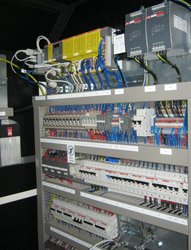
Posted to News on 17th Sep 2015, 16:39
New ABB safety PLC ensures safety of crane operation
Major construction sites are tending to become very congested, in efforts to better exploit the available building space and speed project times. The workhorse tower crane is critical to the efficiency of such sites, and crane operators today often have to work in very complex 3D space envelopes with many potential collision zones. The crane controls designer NTK is making light of these issues by providing an advanced new safety system for tower cranes, which can be recognised easily by the company's distinctive crane cabs with their circular or oval cab windows.

NTK is now installing a control system based around a new generation of safety PLC from ABB. This system continuously monitors load torque as well as working and collision areas in real time, to SIL3 (IEC 61508 and 62061) PLe (ISO 13849-1) functional safety level. It provides instant and comprehensive visibility for the operator of all key crane status indicators. The crane's maximum movement speed is also now controlled by a fully dynamic calculation of load moment. This enhances crane productivity by providing an infinitely adjustable hoisting performance envelope - rather than using more restrictive gradated maximum speed bands.
The safety PLC used - ABB's AC500-S - simplified this control upgrade project because of its built-in maths capabilities. Unlike other safety controller options the PLC supports trigonometric mathematical functions, speeding static and dynamic crane load safety calculations. The position of the trolley, radius of the crane, plus load and wind conditions are all displayed by NTK's graphical touch-screen user interface.
Ralf Tensing, a founder of NTK Ingenieurbro says: "The safety PLC performs complex safety arithmetic functions to monitor key parameters. Among other things, it ensures that maximum permissible load moments are never exceeded, to prevent an overload tipping the crane. Status is now shown in real time. At a glance, the operator can see where the trolley or hoist is, for instance, and what the load is. When you are working on congested sites or at high altitudes, this is a huge advantage."
NTK has consistently been at the forefront of crane control safety. For this iteration of its control system, which upgraded the control system to a dual-PLC architecture with the new maths-capable AC500-S safety PLC, NTK agreed to be one of ABB's beta users. This gave NTK access to the new safety PLC very early in the development cycle. In return, NTK developers gave ABB feedback on the PLC and its development tools.
In total, NTK's new control system was brought to market in around 12 months. However, this included a period when it undertook its own pre-release trial with one its crane OEM customers - who provided NTK with their feedback on the new safety control system. The new safety code itself was developed over a shorter timescale of around three months, thanks in large part to the quality of ABB's programming tools.
High-level language
Instead of programming using specialised safety PLC function blocks, the AC500-S offers a complete safety-certified structured text programming language. This high-level language, which includes the ability to use sophisticated constructs such as IF statements, provided NTK with much greater flexibility to develop its new crane safety monitoring and user interface ideas. In addition, one of the key development tools that helped NTK make the transition from writing "standard' PLC control code to producing safety PLC code, was the availability of ABB's safety code analyser (SCA). This tool verifies that the user is following safety programming rules or guidelines according to IEC 61508-3. As NTK creates new software modules, these can be quickly verified by the SCA tool, which performs a number of checks such as verifying that variables are named properly and that transfers work correctly, and automatically flagging if the code structure is complex and/or uses instructions that could potentially lead to software errors, such as program loops.
Another significant part of the overall development environment for NTK is ABB's Automation Builder toolsuite. This provides an integrated development environment for the spectrum of automation components used in control system projects like NTK's, from PLCs, safety PLCs and motion controllers to drives and HMIs. This tool substantially reduces software complexity and time to market.
Knud Jansen, Product manager for Machinery Controls and Automation at ABB Automation Products says: "This application illustrates how simple it is for PLC users to start adopting safety PLC-based control system architectures. The key drivers for NTK were the ability to program using the high level structured text language, and the powerful safety code analyser tool - which gave the company's software developers instant feedback on PLC code modules as they were developed and tested."
NTK's PLC crane control system is housed in a protected cabinet that sits in the operator cab. However, the PLC can equally be provided in an "extreme conditions' variant that allows users to configure functional safety PLC systems that are also ruggedised and suitable for operating in harsh conditions and extreme climates, as can be commonly found on some crane and winch applications, for instance.
ABB's safety PLC hardware shares the same look and feel as ABB's standard AC500 PLC family for non-safety applications, as well as identical dimensions to standard ABB CPU and I/O modules, and the same mounting and wiring scheme. Both types of modules may be mixed in the same PLC, allowing the system to perform both safety and non-safety functions. This can reduce the complexity and cost of projects, and open up new options for applications such as direct variable mapping and data exchange between safety and non-safety elements of the control system.
The AC500-S's maths capabilities include a powerful suite of functions for trigonometric calculations, including COS, SIN, TAN, ASIN, ACOS and LOG. This is well suited for ensuring safe control of movement in any application involving complex kinematics, such as cranes, hoists, manipulators and mobile platforms (automated guided vehicles).
Quick learning curve
The AC500-S safety CPU is programmed using standard editors such as Structured Text (ST), Ladder (LD) or Function Block Diagram (FBD), making it easy for users to migrate control architectures to a new level of safety. This facilitates a quick learning curve, and quick application development, lowering total cost of ownership of the automation system. ABB's SCA further helps to speed development by verifying the safety programming rules or guidelines according to IEC 61508-3. This powerful tool has been certified by TV SD, who subjected the software to stringent tests. The results are documented in a technical report, which verifies the analyser's features, compliance with standards, and performance in terms of syntax analysis of safety application source code.
A valuable side effect is PLC code that is more reliable, better structured, and more easily readable, contributing to lower certification effort and post-release maintenance costs. Lower costs and faster development are further aided by the AC500-S safety programming editor's support for the well-known PLCopen Safety Library, which includes the standardised function blocks used in safety applications such as E-Stop, Mode Selector, Two-Hand-Control, etc. AC500-S additionally supports a wide range of IEC data types, giving programmers much greater flexibility.
Unlike some safety PLCs, ABB's AC500-S has a separate safety processor. The Safety CPU can be configured to work even if the non-safety processor is in STOP or maintenance mode, or during an online change. ABB offers a choice of SIL3/PL e certified safety I/O modules including digital input and outputs, and a dedicated analogue current input module covering the 0-20mA (or 4-20mA) range. The latter module makes it possible to measure parameters such as pressure, temperature, position and torque on applications directly - without any need for A/D conversion or proprietary electronics. This can simplify the implementation of a wide range of safety-related machinery control applications such as braking systems in hoists and lifting equipment, to positioning systems and temperature control on cranes, mobile platforms and selective shutdown systems on wind power turbines.
To simplify system design, safety-related control modules may be installed as part of the main PLC system, or be sited in a remote I/O rack linked using the PROFINET/PROFIsafe protocol. Network-connected control systems like this save cabling and assembly costs, and avoid problems with interference. In this application, NTK chose to use the PROFINET/PROFIsafe industrial Ethernet standard for its safety-related communications on the crane.
More information about ABB's safety system for tower cranes can be found at www.abb.com/plc.
Want the latest machine building news straight to your inbox? Become a MachineBuilding member for free today >>
ABB Automation Technologies (Instrumentation & Automation)
Howard Road
Eaton Socon
PE19 8EU
UNITED KINGDOM
+44 (0)1480 475 321














